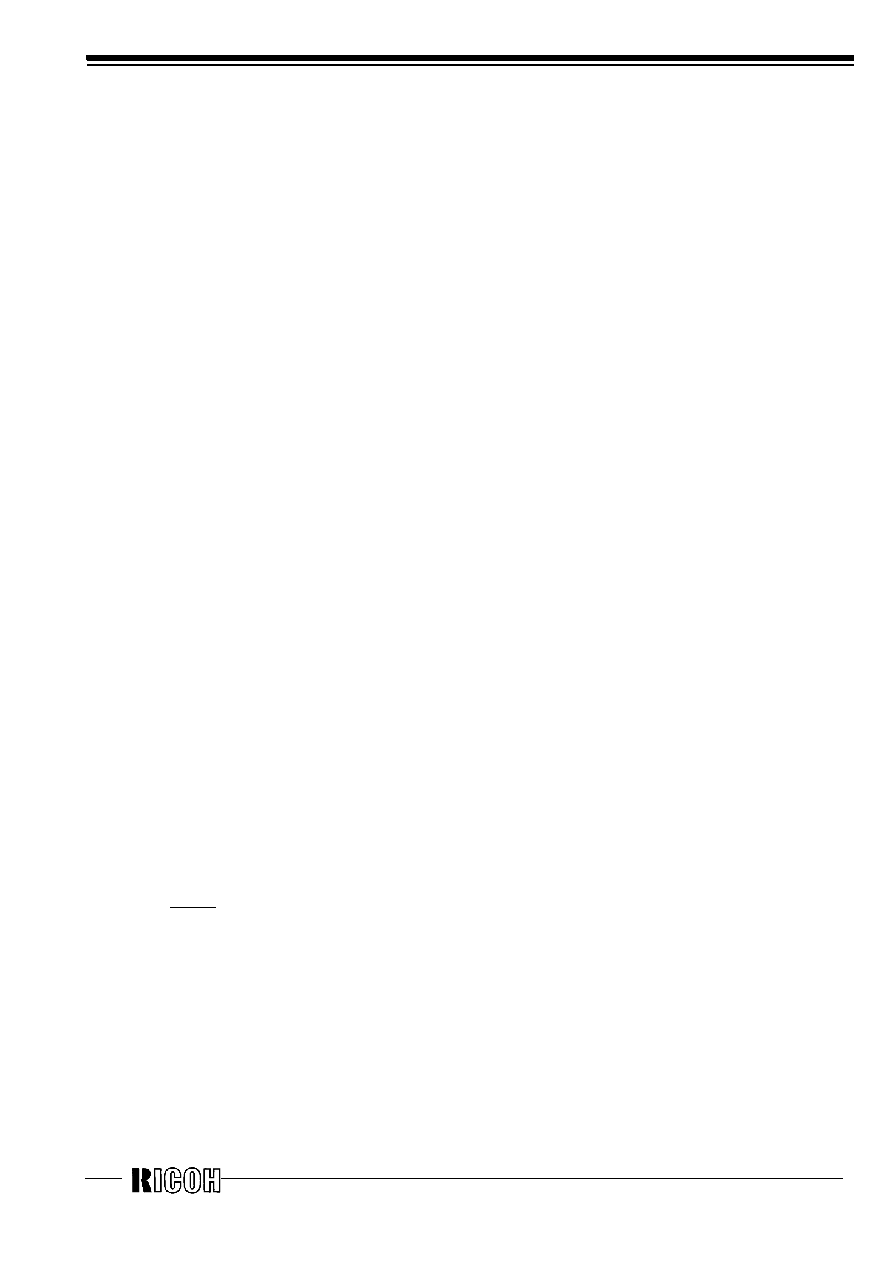- 您現(xiàn)在的位置:買賣IC網(wǎng) > PDF目錄224992 > R1230D121H-TL (RICOH COMPANY LTD) SWITCHING REGULATOR, 920 kHz SWITCHING FREQ-MAX, PDSO8 PDF資料下載
參數(shù)資料
| 型號: | R1230D121H-TL |
| 廠商: | RICOH COMPANY LTD |
| 元件分類: | 穩(wěn)壓器 |
| 英文描述: | SWITCHING REGULATOR, 920 kHz SWITCHING FREQ-MAX, PDSO8 |
| 封裝: | 0.9 MM HEIGHT, SON-8 |
| 文件頁數(shù): | 2/20頁 |
| 文件大?。?/td> | 401K |
| 代理商: | R1230D121H-TL |

Rev. 1.20
- 10 -
referred to as the discontinuous mode and the latter mode is referred to as continuous mode.
In the continuous mode, when Equation 1 is solved for ton and assumed that the solution is tonc,
tonc =T
×VIN/VOUT Equation 2
When ton<tonc, the mode is the discontinuous mode, and when ton=tonc, the mode is the continuous mode.
s
OUTPUT CURRENT AND SELECTION OF EXTERNAL COMPONENTS
When P-channel Tr. of Lx is ON:
(Wherein, Ripple Current P-P value is described as IRP, ON resistance of P-channel Tr. and N-channel Tr. of Lx are
respectively described as Ronp and Ronn, and the DC resistor of the inductor is described as RL.)
VIN=VOUT+(Ronp+RL)
×IOUT+L×IRP/ton
Equation 3
When P-channel Tr. of Lx is “OFF”(N-channel Tr. is “ON”):
L
×IRP/toff = RL×IOUT + VOUT + Ronn×IOUT
Equation 4
Put Equation 4 to Equation 3 and solve for ON duty of P-channel transistor, ton/(toff+ton)=DON,
DON=(VOUT-Ronn
×IOUT+RL×IOUT)/(VIN+ Ronn×IOUT -Ronp×IOUT)Equation 5
Ripple Current is as follows;
IRP=(VIN-VOUT-Ronp
×IOUT-RL×IOUT)×DON/fosc/L
…Equation 6
wherein, peak current that flows through L, and Lx Tr. is as follows;
ILmax=IOUT+IRP/2
…Equation 7
Consider ILmax, condition of input and output and select external components.
5
The above explanation is directed to the calculation in an ideal case in continuous mode.
s How to Adjust Output Voltage and about Phase Compensation
As for Adjustable Output type, feedback pin (VFB) voltage is controlled to maintain 0.8V.
Output Voltage, VOUT is as following equation;
VOUT: R1+R2=VFB: R2
VOUT=VFB
×(R1+R2)/R2
Thus, with changing the value of R1 and R2, output voltage can be set in the specified range.
In the DC/DC converter, with the load current and external components such as L and C, phase might be behind 180
degree. In this case, the phase margin of the system will be less and stability will be worse. To prevent this, phase
margin should be secured with proceeding the phase. A pole is formed with external components L and COUT.
Fpole
1/2π√LCOUT
A zero (signal back to zero) is formed with R1 and Cb.
Fzero1/(2π×R1×Cb)
First, choose the appropriate value of R1, R2 and Cb.
Set R1+R2 value 100k
or less.
For example, if L=10
H, COUT=10F, the cut off frequency of the pole is approximately 16kHz.
To make the cut off frequency of the zero more than 16kHz, for example, set R1=42k
and Cb=100pF.
If VOUT is set at 1.5V, R2=48k
is appropriate.
If a ceramic capacitor is desirable as COUT in your application, nonetheless of the usage of both the fixed output
voltage type and adjustable output type, add 0.2
or more resistance to compensate the ESR.
Further, if a ceramic capacitor is desirable to use as COUT without adding another resister to compensate the ESR,
phase should be back drastically. To make it, R2 value should be smaller compared to R1. As a result, the set output
voltage may be large. For example, to make VOUT=1.5V, constants are R1=42k
, R2=48k, and Cb=100pF. If the
ceramic capacitor is used, under the heavy load condition, oscillation may be result. On the other hand, if R2=12k
相關(guān)PDF資料 |
PDF描述 |
|---|---|
| R1230D161H-TL | SWITCHING REGULATOR, 920 kHz SWITCHING FREQ-MAX, PDSO8 |
| R1230D201G-TL | SWITCHING REGULATOR, 575 kHz SWITCHING FREQ-MAX, PDSO8 |
| R1230D281E-TL | SWITCHING REGULATOR, 575 kHz SWITCHING FREQ-MAX, PDSO8 |
| R1242S001F-E2-FE | SWITCHING REGULATOR, 550 kHz SWITCHING FREQ-MAX, PDSO8 |
| R125.461.171 | PANEL MOUNT, FEMALE, SMA CONNECTOR, RECEPTACLE |
相關(guān)代理商/技術(shù)參數(shù) |
參數(shù)描述 |
|---|---|
| R1230D131A-TL | 制造商:未知廠家 制造商全稱:未知廠家 功能描述:SMPS Controller |
| R1230D131A-TR | 制造商:未知廠家 制造商全稱:未知廠家 功能描述:SMPS Controller |
| R1230D131B-TL | 制造商:未知廠家 制造商全稱:未知廠家 功能描述:SMPS Controller |
| R1230D131B-TR | 制造商:未知廠家 制造商全稱:未知廠家 功能描述:SMPS Controller |
| R1230D141A-TL | 制造商:未知廠家 制造商全稱:未知廠家 功能描述:SMPS Controller |
發(fā)布緊急采購,3分鐘左右您將得到回復(fù)。